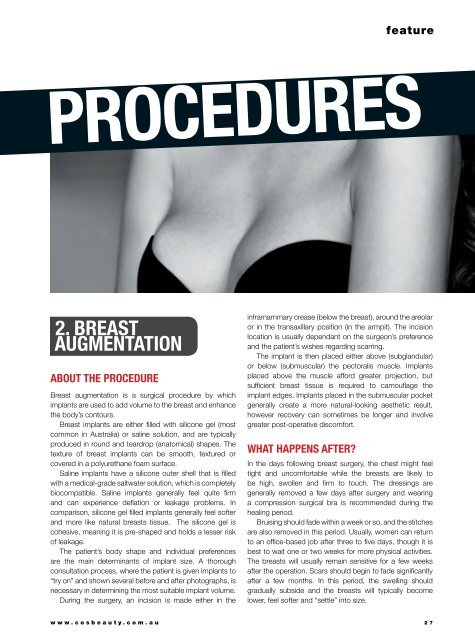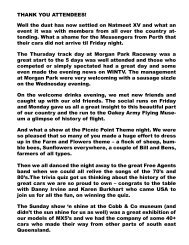Cosmetic Surgery & Beauty #72
Cosmetic Surgery and Beauty is the definitive consumer guide to aesthetic enhancement in Australia. Written by medical journalists and industry experts CSBM covers everything you need to know and with hundreds of untouched before and after photos it is the authoritative information source.
Cosmetic Surgery and Beauty is the definitive consumer guide to aesthetic enhancement in Australia. Written by medical journalists and industry experts CSBM covers everything you need to know and with hundreds of untouched before and after photos it is the authoritative information source.
You also want an ePaper? Increase the reach of your titles
YUMPU automatically turns print PDFs into web optimized ePapers that Google loves.
feature<br />
procedures<br />
2. Breast<br />
augmentation<br />
About the procedure<br />
Breast augmentation is a surgical procedure by which<br />
implants are used to add volume to the breast and enhance<br />
the body’s contours.<br />
Breast implants are either filled with silicone gel (most<br />
common in Australia) or saline solution, and are typically<br />
produced in round and teardrop (anatomical) shapes. The<br />
texture of breast implants can be smooth, textured or<br />
covered in a polyurethane foam surface.<br />
Saline implants have a silicone outer shell that is filled<br />
with a medical-grade saltwater solution, which is completely<br />
biocompatible. Saline implants generally feel quite firm<br />
and can experience deflation or leakage problems. In<br />
comparison, silicone gel filled implants generally feel softer<br />
and more like natural breasts tissue. The silicone gel is<br />
cohesive, meaning it is pre-shaped and holds a lesser risk<br />
of leakage.<br />
The patient’s body shape and individual preferences<br />
are the main determinants of implant size. A thorough<br />
consultation process, where the patient is given implants to<br />
“try on” and shown several before and after photographs, is<br />
necessary in determining the most suitable implant volume.<br />
During the surgery, an incision is made either in the<br />
inframammary crease (below the breast), around the areolar<br />
or in the transaxillary position (in the armpit). The incision<br />
location is usually dependant on the surgeon’s preference<br />
and the patient’s wishes regarding scarring.<br />
The implant is then placed either above (subglandular)<br />
or below (submuscular) the pectoralis muscle. Implants<br />
placed above the muscle afford greater projection, but<br />
sufficient breast tissue is required to camouflage the<br />
implant edges. Implants placed in the submuscular pocket<br />
generally create a more natural-looking aesthetic result,<br />
however recovery can sometimes be longer and involve<br />
greater post-operative discomfort.<br />
What happens after?<br />
In the days following breast surgery, the chest might feel<br />
tight and uncomfortable while the breasts are likely to<br />
be high, swollen and firm to touch. The dressings are<br />
generally removed a few days after surgery and wearing<br />
a compression surgical bra is recommended during the<br />
healing period.<br />
Bruising should fade within a week or so, and the stitches<br />
are also removed in this period. Usually, women can return<br />
to an office-based job after three to five days, though it is<br />
best to wait one or two weeks for more physical activities.<br />
The breasts will usually remain sensitive for a few weeks<br />
after the operation. Scars should begin to fade significantly<br />
after a few months. In this period, the swelling should<br />
gradually subside and the breasts will typically become<br />
lower, feel softer and “settle” into size.<br />
www.cosbeauty.com.au 27


















